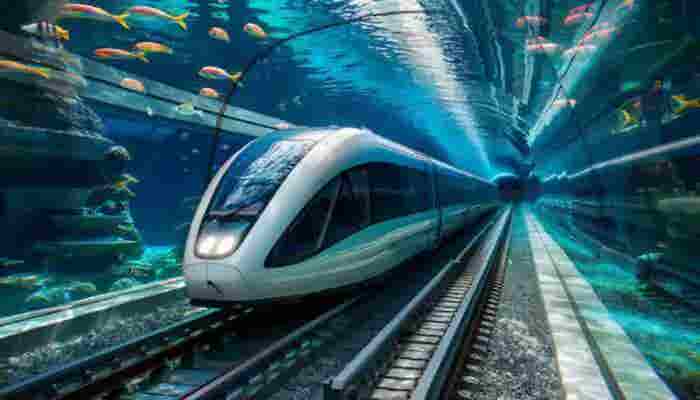UAE plans world’s first underwater bullet train connecting Dubai to Mumbai
UAE unveils plans for a record-breaking underwater train linking Dubai and Mumbai, blending high-speed travel with marine views.

The UAE is taking a giant leap in global transport with a planned underwater bullet train linking Dubai and Mumbai, promising high speeds, marine views, and new trade routes. (CREDIT: CC BY-SA 4.0)
A groundbreaking transportation project is in the works—one that could forever change how long-distance travel is imagined. The United Arab Emirates has revealed plans for a massive underwater train that would connect the port city of Fujairah with Mumbai, India’s financial hub.
Covering nearly 1,200 miles beneath the Arabian Sea, this engineering marvel aims to combine speed, luxury, and scenic immersion. With a projected travel speed between 600 and 1,000 kilometers per hour, the journey promises to outpace flights, offering a smoother, more visually captivating experience.
“This is not just about transport, but an immersive experience,” said Dr. Ahmed Al Hariri, who leads the UAE’s National Advisor Bureau. The train, initially floated as an idea in 2018, is no longer a mere concept. Now actively pursued, it blends utility with spectacle.
Panoramic windows lining the tunnel will allow travelers to witness the vibrant underwater world while racing beneath the waves. With both countries looking to expand trade and tourism, the project is more than a marvel—it’s a strategic bridge between two thriving regions.
Beyond Transit: Trade, Tourism, and Rivalry
This high-speed rail isn’t solely about moving people across borders. It’s designed to serve dual purposes—transporting goods such as freshwater from India to the UAE and oil in the reverse direction. Dubai sees it as a way to deepen trade partnerships with India while also redefining what tourism can be.
As the UAE pushes ahead, the project has stirred comparisons with Saudi Arabia’s $1 trillion NEOM city initiative. Both Gulf nations are competing to lead the region’s next wave of futuristic infrastructure. If Dubai completes this undersea route before NEOM opens its doors, it could gain a symbolic edge. Sara Ahmed, a travel blogger based in Dubai, emphasized the project’s allure: “The underwater train isn’t just about getting from point A to B. It’s about relishing the wonders of the marine world.”
The rivalry isn’t just about spectacle. Both countries aim to become global symbols of innovation. While Saudi Arabia builds artificial islands and futuristic skylines, the UAE is diving into the ocean to carve out its legacy.
Related Stories
- Groundbreaking high-speed train just set a new record and could travel fast as an airplane
- Joby Aviation’s electric air taxi set to revolutionize urban mobility
- Next-generation jet engine converts electricity directly into thrust
The Technical Mountain Ahead
Building such a colossal structure beneath the sea comes with significant engineering and financial challenges. The train would need to withstand intense water pressure, ensure passenger safety at high speeds, and deliver reliability over thousands of trips. There are also psychological barriers to overcome—some people may feel claustrophobic or uneasy traveling deep underwater.
Rajesh Verma, a businessman in Mumbai, expressed caution: “I’ve always been wary of the ocean’s depths. As much as I love the idea, I’ll likely stick to conventional modes of transport.” For many, it’s not just about the technology, but the comfort of knowing it works without flaws.
Still, the financial commitment is not the UAE’s greatest concern. With deep pockets and a track record of delivering iconic projects—from the world’s tallest skyscraper to the man-made Palm Islands—Dubai’s leaders are more focused on technological feasibility than on cost. Experts estimate the project could cost several billion dollars, depending on materials, design, and the tunnel’s complexity.
Initial reports suggest the use of transparent materials instead of traditional opaque bricks, creating a unique window into the marine ecosystem. That vision aligns with the broader goal of crafting an unforgettable travel experience rather than just a faster commute.
A Journey Like No Other
If completed, the Dubai-Mumbai train will dwarf the Channel Tunnel between England and France in both scale and ambition. While the Channel Tunnel spans just 35 miles and runs at modest speeds of 70 miles per hour, this new project plans to stretch over 1,200 miles and operate at speeds ten times faster.
Passengers will not just travel—they will encounter an oceanic world through the train’s clear walls. The experience could easily find a place on travelers’ bucket lists. Some have already begun referring to it as the "Deep Blue Express."
However, the question remains: can such a massive project be delivered safely and sustainably? Those behind the project believe so. A feasibility report is now being commissioned to explore the materials, construction methods, and environmental impact. That report will shape whether the idea remains a dream or becomes the world's most advanced rail system.
The train’s potential extends beyond engineering or aesthetics. It’s a bold statement about how humans can rethink geography. It’s a bridge between cultures, markets, and innovations. Whether it becomes a staple of global travel or serves as inspiration for future projects, the underwater train project already stands as a testament to human vision and determination.
What the Future Holds
The success of this bold venture will rest on more than just construction. Public confidence, regulatory approvals, and environmental planning must align. Nonetheless, the Dubai-Mumbai train has sparked imaginations across the world and ignited new discussions about what’s possible in global travel.
At a time when nations are reimagining how cities and transport networks interact, this project represents the next logical step: one that literally plunges into uncharted waters. As with most pioneering ventures, it may take years, if not decades, to complete. But its very announcement pushes the boundaries of what’s considered possible.
Whether you one day ride the Deep Blue Express or watch its progress from afar, its story marks a new era in engineering and global connection. And for the UAE, it’s another chance to show that when it comes to bold ideas, no challenge is too deep.
Today’s Longest High-Speed Rail Journeys
Beijing to Kunming, China: Covering approximately 2,653 kilometers, this route connects Beijing with Kunming, offering travel times between 10 hours 43 minutes and 14 hours 54 minutes.
Beijing to Guangzhou, China: Spanning about 2,298 kilometers, this line links Beijing to Guangzhou, significantly reducing travel time compared to conventional trains.
Shanghai to Kunming, China: This route extends over 2,066 kilometers, connecting Shanghai with Kunming, facilitating efficient travel across eastern and southwestern China.
Beijing to Shanghai, China: At approximately 1,318 kilometers, this line connects two of China's major cities, Beijing and Shanghai, and is noted as the world's longest high-speed line constructed in a single phase.
Hangzhou to Shenzhen, China: This route covers around 1,495 kilometers, linking Hangzhou with Shenzhen, enhancing connectivity along China's southeastern coast.
Qingdao to Yinchuan, China: Spanning about 1,762 kilometers, this line connects Qingdao to Yinchuan, facilitating travel between eastern and northwestern China.
Beijing to Harbin, China: This route extends over approximately 1,700 kilometers, linking Beijing with Harbin, serving as a vital connection to northeastern China.
Guangzhou to Kunming, China: Covering about 1,285 kilometers, this line connects Guangzhou with Kunming, enhancing travel between southern and southwestern China.
Tokyo to Hakata, Japan: This route spans approximately 1,174 kilometers, connecting Tokyo with Hakata, and is part of Japan's renowned Shinkansen network.
Madrid to Barcelona, Spain: Covering about 621 kilometers, this line links Madrid with Barcelona, significantly reducing travel time between Spain's two largest cities.
The Seikan Tunnel in Japan is the world's current longest undersea tunnel used by bullet trains. Spanning 53.85 kilometers (33.46 miles), it includes a 23.3-kilometer (14.5-mile) section beneath the Tsugaru Strait, connecting Honshu and Hokkaido. Shinkansen bullet trains traverse this tunnel, which descends approximately 100 meters (330 feet) below the seabed and 240 meters (790 feet) below sea level.
These high-speed rail routes exemplify advancements in rail technology, offering rapid and efficient transportation across vast distances.
Note: Materials provided above by The Brighter Side of News. Content may be edited for style and length.
Like these kind of feel good stories? Get The Brighter Side of News' newsletter.



